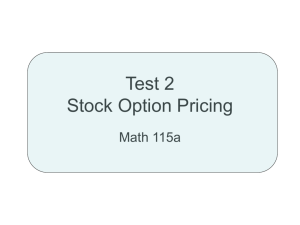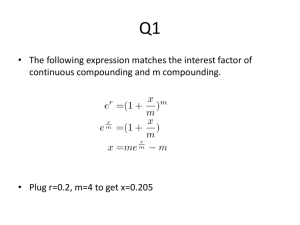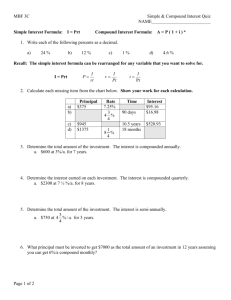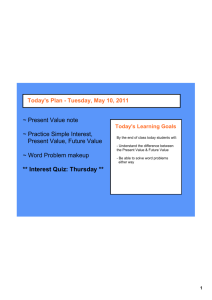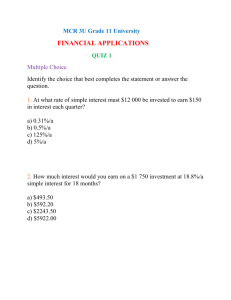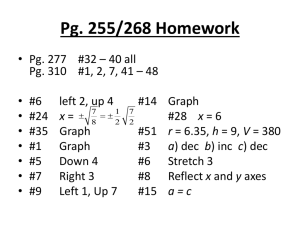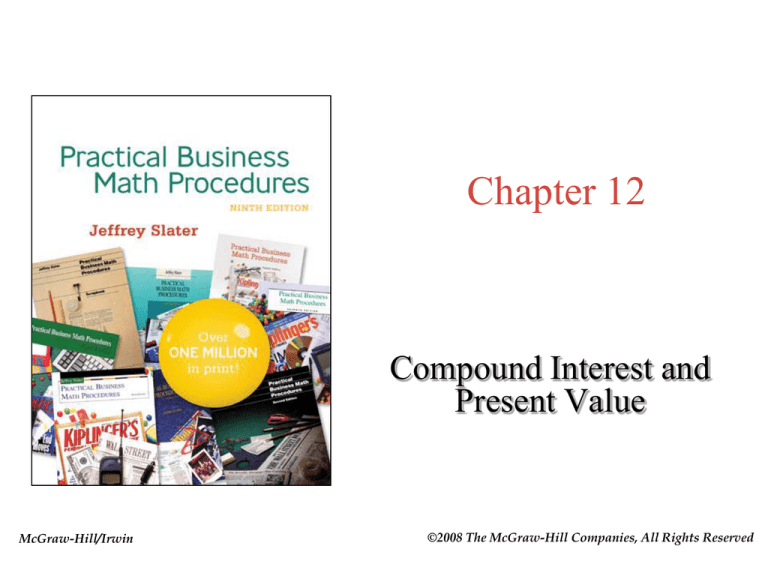
Chapter 12
Compound Interest and
Present Value
McGraw-Hill/Irwin
©2008 The McGraw-Hill Companies, All Rights Reserved
#12
Compound Interest and Present Value
Learning Unit Objectives
LU12.1
Compound Interest (Future Value) –
The Big Picture
• Compare simple interest with compound
interest
• Calculate the compound amount and
interest manually and by table lookup
• Explain and compute the effective rate
12-2
#12
Compound Interest and Present Value
Learning Unit Objectives
LU12.2
Present Value -- The Big Picture
• Compare present value (PV) with
compound interest (FV)
• Compute present value by table lookup
• Check the present value answer by
compounding
12-3
Compounding
• Compounding: The process of calculating the
interest periodically over the life of the loan (or
an investment).
• After each calculation, the interest is added to
the loan, and starts to accrue additional interest
for the next period based on the adjusted
principal (equal to the previous principal plus
the interest).
12-4
Compound Interest
• Compound interest: Interest on the principal of
the loan, plus the interest on all the accrued
interests (the interests of all previous periods).
12-5
Future Value (Compound Amount)
• Future value (or Compound amount): The final
amount of the loan or the investment at the end
of the last period.
• Refer to the next slide to explore $1 will grow in
the value of at 8% in 4 consecutive years.
$1
12-6
Figure 12.1 Future Value of $1 at 8%
for Four Periods
Compounding goes from present value to future value
$5.00
$4.50
$4.00
$3.50
$3.00
$2.50
$2.00
$1.50
$1.00
$0.50
$0.00
Future
Value
Present
value
After 1
period
$1 is
worth
$1.08
$1.00
$1.08
0
1
After 2
periods
$1 is
worth
$1.17
$1.1664
2
After 3
periods
$1 is
worth
$1.26
$1.2597
3
Number of periods
12-7
After 4
periods
$1 is
worth
$1.36
$1.3605
4
Growth of $1 in 4 Years at 8%
• Present: $1
• After 1 year: $1.08
(end of year 1)
• After 2 years: $1.17 (end of year 2)
• After 3 years: $1.26 (end of year 3)
• After 4 years: $1.36
(end of year 4)
• Future value of $1 at 8% in 4 years: $1.36
12-8
Figure 12.1 Future Value of $1 at 8%
for Four Periods
Manual Calculation
Year 1
Year 2
Year 3
Year 4
$
1.00 $
1.08 $
1.17 $
1.26
0.08
x 0.08
x 0.08
x 0.08
Interest
$
0.08 $
0.09 $
0.09 $
0.10
Beg. Bal
1.00
1.08
1.17
1.26
End of year $
1.08 $
1.17 $
1.26 $
1.36
12-9
Present Value vs Future Value
• Present value: The value of money as of today.
• Future value (or Compound amount): The final
amount of the money, loan or investment at the
end of the last period.
12-10
Compounding Interest (Future Value)
Compounding - involves the
calculation of interest
periodically over the life of
the loan or investment
Future value (compound amount)
- is the final amount of the loan or
investment at the end of the last
period
12-11
Compound interest - the interest
on the principal plus the interest
of prior periods
Present value - the value of a
loan or investment today
Compounding Terms
12-12
Compounding Periods
Interested Calculated
Compounding Annually
Once a year
Compounding Semiannually
Every 6 months
Compounding Quarterly
Every 3 months
Compounding Monthly
Every month
Compounding Daily
Every day
Simple Interest Formula
Recall Chapter 10
Simple Interest (I) = Principal (P) x Rate (R) x Time (T)
Stated as a
Percent
Stated as a
Percent
12-13
Simple Versus Compound Interest
Simple
Compounded
Al Jones deposited $1,000 in a
savings account for 5 years at
an annual interest rate of 10%.
What is Al’s simple interest
and maturity value?
I=PxRxT
I = $1,000 x .10 x 5
I = $500
MV = $1,000 + $500
MV = $1,500
12-14
Al Jones deposited $1,000 in
a savings account for 5 years
at an annual compounded rate
of 10%. What is Al’s interest
and compounded amount?
Year 1
$ 1,000.00
x .10
Interest $ 100.00
Beg. Bal
1000.00
End of year $ 1,100.00
Year 2
$ 1,100.00
x .10
$ 110.00
1100.00
$ 1,210.00
Year 3
$ 1,210.00
x .10
$ 121.00
1210.00
$ 1,331.00
Year 4
$ 1,331.00
x .10
$ 133.10
1331.00
$ 1,464.10
Interest: $1,610.51 - $1,000 = $610.51
Year 5
$ 1,464.10
x .10
$ 146.41
1464.10
$ 1,610.51
Calculating Compound Amount & Interests
1. Manual Method
(As in the previous slide)
2. Look-up Method from a Table
Use the formula:
Principal x Table factor = Compound
Amount
(Future Value)
How to find Table factor:
* Define the number of periods of interest
* Define the appropriate rate for each
period.
12-15
Tools for Calculating Compound Interest
Number of periods (N)
Number of years
multiplied the number
of times the interest is
compounded per year
Rate for each period
(R) Annual interest rate
divided by the number
of times the interest is
compounded per year
If you compounded $100 for 3 years at 6% annually,
semiannually, or quarterly What is N and R?
Periods
Annually:
3 yrsx 1 = 3
Semiannually: 3 yrs x 2 = 6
Quarterly: 3 yrs x 4 = 12
12-16
Rate
Annually:
6% / 1 = 6%
Semiannually: 6% / 2 = 3%
Quarterly: 6% / 4 = 1.5%
Calculating Compound Amount
by Table Lookup
Step 4. Multiply the table factor
by the amount of the loan.
Step 3. Go down the period column of the
table to the number desired; look across the
row to find the rate. At the intersection is
the table factor
Step 2. Find the rate: Annual rate divided
by number of times interest is
compounded in 1 year
Step 1. Find the periods: Years multiplied by
number of times interest is compounded in 1 year
12-17
Table 12.1 - Future Value of $1
at Compound Interest
Future value of $1 at compound interest (Partial)
12-18
Period
1%
1.50%
2%
3%
4%
5%
6%
7%
8%
9%
10%
1
1.0100
1.0150
1.0200
1.0300
1.0400
1.0500
1.0600
1.0700
1.0800
1.0900
1.1000
2
1.0201
1.0302
1.0404
1.0609
1.0816
1.1025
1.1236
1.1449
1.1664
1.1881
1.2100
3
1.0300
1.0457
1.0612
1.0927
1.1249
1.1576
1.1910
1.2250
1.2597
1.2950
1.3310
4
1.0406
1.0614
1.0824
1.1255
1.1699
1.2155
1.2625
1.3108
1.3605
1.4116
1.4641
5
1.0510
1.0773
1.1041
1.1593
1.2167
1.2763
1.3382
1.4026
1.4693
1.5386
1.6105
6
1.0615
1.0934
1.1262
1.1941
1.2653
1.3401
1.4185
1.5007
1.5869
1.6771
1.7716
7
1.0721
1.1098
1.1487
1.2299
1.3159
1.4071
1.5036
1.6058
1.7138
1.8280
1.9487
8
1.0829
1.1265
1.1717
1.2668
1.3686
1.4775
1.5938
1.7182
1.8509
1.9926
2.1436
9
1.0937
1.1434
1.1951
1.3048
1.4233
1.5513
1.6895
1.8385
1.9990
2.1719
2.3579
10
1.1046
1.1605
1.2190
1.3439
1.4802
1.6289
1.7908
1.9672
2.1589
2.3674
2.5937
11
1.1157
1.1780
1.2434
1.3842
1.5395
1.7103
1.8983
2.1049
2.3316
2.5804
2.8531
12
1.1260
1.1960
1.2682
1.4258
1.6010
1.7959
2.0122
2.2522
2.5182
2.8127
3.1384
13
1.1381
1.2135
1.2936
1.4685
1.6651
1.8856
2.1329
2.4098
2.7196
3.0658
3.4523
14
1.1495
1.2318
1.3195
1.5126
1.7317
1.9799
2.2609
2.5785
2.9372
3.3417
3.7975
15
1.1610
1.2502
1.3459
1.5580
1.8009
2.0789
2.3966
2.7590
3.1722
3.6425
4.1772
Calculating Compound Amount
by Table Lookup
Steve Smith deposited $80 in a savings account for 4
years at an annual compounded rate of 8%. What is
Steve’s interest and compounded amount?
N=4x1=4
120
R = 8% = 8%
1
Table Factor = 1.3605
100
Compounded Amount:
$80 x 1.3605 = $108.84
I = $108.84 - $80 = $28.84
12-19
80
60
Investment
40
20
0
2007
2008
2009
2010
Practice
John deposits $1,000 in his savings account that pays
6% interest compounded quarterly. What will be
the balance of his account at the end of 6 years?
Step1: Calculate the numbers of periods:
Periods = 4 x 6 years = 24 periods.
Step 2: Calculate the appropriate period rate:
Rate = 6% / 4 = 1.50%
Step 3: Locate the table factor:
24 periods, at 1.5%
Look up Table factor =1.4295
Step 4: Use the formula:
Principal x Table factor
12-20
= $1,000 x 1.4295
= $1,4295
Problem 12-13:
Solution:
Loan: $25,000
7 years at 4% interest compounded
semiannually.
7 years x 2 = 14 periods
4% = 2% (Period rate)
2
$25,000.00 x 1.3195 = $32,987.50
Lookup table factor
Loan amount
12-21
Compound amount
(Future value) at
the end of 7 years
Problem 12-15:
Solution:
Which bank provides higher
compound amount?
Four Rivers
Mystic
4 years x 2 = 8 periods
10%
= 5%
2
$10,000 x 1.4775 = $14,775
- 10,000
$ 4,775
Lookup table factor
12-22
4 years x 4 = 16 periods
8% = 2%
4
$10,000 X 1.3728 = $13,728
-10,000
$ 3,728
Lookup table factor
Problem 12-16:
Solution:
Compound amount at end of year 4
Lookup table factor
3 years x 2 = 6 periods
12%
= 6%
2
Original deposit: $20,000
$20,000 x 1.4185 = $28,370
Add extra amount
for year 5)
+30,000
$58,370
$58,370 x 1.4185 = $82,797.85
Lookup table factor
12-23
Total amount of deposit
at the beginning of year
5.
Nominal and Effective Rates (APY) of Interest
Nominal Rate (Stated Rate) - The
rate on which the bank calculates
interest.
Annual Percentage Yield Formula
Effective Rate = Interest for 1 year
(APY)
Principal
12-24
Calculating Effective Rate APY
12-25
Blue, 8% compounded quarterly
Periods = 4
(4 x 1)
Percent = 8% = 2%
4
Principal = $8,000
Table 12.1 lookup: 4 periods, 2%
1.0824
x $8,000
Less
$8,659.20
$8,000.00
659.20
APY
659.20 = .0824
$8,000
= 8.24%
It has a greater APY when the
frequency of compounding
increases.
Sun, 8% compounded semiannually
Periods = 2
(2 x 1)
Percent = 8% = 4%
2
Principal = $8,000
Table 12.1 lookup: 2 periods, 4%
1.0816
x $8,000
Less
$8,652.80
$8,000.00
652.80
APY
652.80 = .0816
$8,000
= 8.16%
Figure 12.3 - Nominal and Effective Rates
(APY) of Interest Compared
Beginning
balance
$1,000
Nominal rate
of interest
+ 6%
Compounding
period
End
balance
Effective rate
(APY) of interest
Annual
$1,060.00
6.00
Semiannual
$1,060.90
6.09%
Quarterly
$1,061.40
6.14%
Daily
$1,061.80
6.18%
Daily compounding provides the highest effective rate
(APY) of interest.
12-26
Table 12.2 - Compounding Interest Daily
Interest on a 1% deposit compounded daily -360 day basis
12-27
Period
6.00%
6.50%
7.00%
7.50%
8.00%
8.50%
9.00%
9.50%
10.00%
1
1.0618
1.0672
1.0725
1.0779
1.0833
1.0887
1.0942
1.0996
1.1052
2
1.1275
1.1388
1.1503
1.1618
1.1735
1.1853
1.1972
1.2092
1.2214
3
1.1972
1.2153
1.2337
1.2523
1.2712
1.2904
1.3099
1.3297
1.3498
4
1.2712
1.2969
1.3231
1.3498
1.3771
1.4049
1.4333
1.4622
1.4917
5
1.3498
1.3840
1.4190
1.4549
1.4917
1.5295
1.5862
1.6079
1.6486
6
1.4333
1.4769
1.5219
1.5682
1.6160
1.6652
1.7159
1.7681
1.8220
7
1.5219
1.5761
1.6322
1.6904
1.7506
1.8129
1.8775
1.9443
2.0136
8
1.6160
1.6819
1.7506
1.8220
1.8963
1.9737
2.0543
2.1381
2.2253
9
1.7159
1.7949
1.8775
1.9639
2.0543
2.1488
2.2477
2.3511
2.4593
10
1.8220
1.9154
2.0136
2.1168
2.2253
2.3394
2.4593
2.5854
2.7179
15
2.4594
2.6509
2.8574
3.0799
3.3197
3.5782
3.8568
4.1571
4.4808
20
3.3198
3.6689
4.0546
4.4810
4.9522
5.4728
6.0482
6.6842
7.3870
25
4.4811
5.0777
5.7536
6.5195
7.3874
8.3708
9.4851
10.7477
12.1782
30
6.0487
7.0275
8.1645
9.4855
11.0202
12.8032
14.8747
17.2813
20.0772
Compounding Interest Daily
Calculate what $2,000 compounded daily for 7 years will
grow to at 6%
Use “Compounding
Interest Daily Table
N=7
R = 6%
Factor 1.5219
$2,000 x 1.5219 = $3,043.80
12-28
Figure 12.4 Present Value of $1 at 8%
for Four Periods
Present value goes from the future value to the present value
$1.20
$1.10
$1.00
$0.90
$0.80
$0.70
$0.60
$0.50
$0.40
$0.30
$0.20
$0.10
$0.00
Future
Value
Present
value
$.7350
0
$.7938
1
$.8573
2
$.9259
3
Number of periods
12-29
$1.0000
4
Calculating Present Value by Table Lookup
Step 4. Multiply the table factor
by the future value. This is the
present value.
Step 3. Go down the period column of the
table to the number desired; look across the
row to find the rate. At the intersection is
the table factor.
Step 2. Find the rate: Annual rate
divided by number of times interest is
compounded in 1 year
Step 1. Find the periods: Years multiplied by
number of times interest is compounded in 1 year
12-30
Table 12.3 - Present Value of $1 at End Period
Present value of $1 at end period (Partial)
12-31
Period
1%
1.50%
2%
3%
4%
5%
6%
7%
8%
9%
10%
1
0.9901
0.9852
0.9804
0.9709
0.9615
0.9524
0.9434
0.9346
0.9259
0.9174
0.9091
2
0.9803
0.9707
0.9612
0.9426
0.9246
0.9070
0.8900
0.8734
0.8573
0.8417
0.8264
3
0.9706
0.9563
0.9423
0.9151
0.8890
0.8638
0.8396
0.8163
0.7938
0.7722
0.7513
4
0.9610
0.9422
0.9238
0.8885
0.8548
0.8227
0.7921
0.7629
0.7350
0.7084
0.6830
5
0.9515
0.9283
0.9057
0.8626
0.8219
0.7835
0.7473
0.7130
0.6806
0.6499
0.6209
6
0.9420
0.9145
0.8880
0.8375
0.7903
0.7462
0.7050
0.6663
0.6302
0.5963
0.5645
7
0.9327
0.9010
0.8706
0.8131
0.7599
0.7107
0.6651
0.6227
0.5835
0.5470
0.5132
8
0.9235
0.8877
0.8535
0.7894
0.7307
0.6768
0.6274
0.5820
0.5403
0.5019
0.4665
9
0.9143
0.8746
0.8368
0.7664
0.7026
0.6446
0.5919
0.5439
0.5002
0.4604
0.4241
10
0.9053
0.8617
0.8203
0.7441
0.6756
0.6139
0.5584
0.5083
0.4632
0.4224
0.3855
11
0.8963
0.8489
0.8043
0.7224
0.6496
0.5847
0.5268
0.4751
0.4289
0.3875
0.3505
12
0.8874
0.8364
0.7885
0.7014
0.6246
0.5568
0.4970
0.4440
0.3971
0.3555
0.3186
13
0.8787
0.8240
0.7730
0.6810
0.6006
0.5303
0.4688
0.4150
0.3677
0.3262
0.2897
14
0.8700
0.8119
0.7579
0.6611
0.5775
0.5051
0.4423
0.3878
0.3405
0.2992
0.2633
15
0.8613
0.7999
0.7430
0.6419
0.5553
0.4810
0.4173
0.3624
0.3152
0.2745
0.2394
Comparing Compound Interest (FV)
Table 12.1 with Present Value (PV) Table 12.3
Compound value Table 12.1
Table
Present Future
12.1
Value
Value
Present value Table 12.3
Table
Future
Present
12.3
Value
Value
1.3605 x
0.7350 x $108.84 = $80.00
$80 = $108.84
(N = 4, R = 8)
We know the
present dollar
amount and find
what the dollar
amount is worth in
the future
12-32
(N = 4, R = 8)
We know the
future dollar
amount and find
what the dollar
amount is worth
in the present
Problem 12-25:
Solution:
Compounding
Present value
10 periods
5 years x 2 = 10 periods
6%
Future value: $15,000
12%
= 6%
2
Calculate present value
Calculate future value:
$15,000 x 0.55 = $8,376
$10,000 x 1.7908 = $17,908
Present value
Yes.
12-33
OR
Calculating Present Value Amount
by Table Lookup
Steve Smith needs $108.84 in 4 years. His bank offers 8% interest
compounded annually. How much money must Steve put in the
bank today (present) to reach his goal in 4 years?
N=4x1=4
120
Invest
Today
R = 8% = 8%
1
Table Factor = 0.7350
Compounded Amount:
$108.84 x 0.7350 = $80.00
100
80
60
Investment
40
20
0
2007
12-34
2008
2009
2010
Problem 12-27:
Solution:
Find present value of a future
amount (cost of college tuition):
8 years x 2 = 16 periods
6%
= 3%
2
Present value of $6,000 is:
$6,000 x 0.6232 = $3,739.20
Lookup table factor
12-35
Homework
12-36
12-1
12-3
12-5
12-8
12-12
12-19
12-28
12-30

